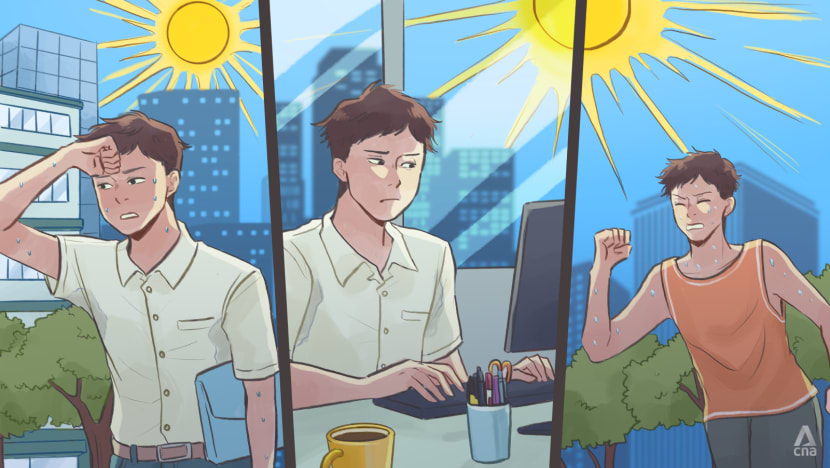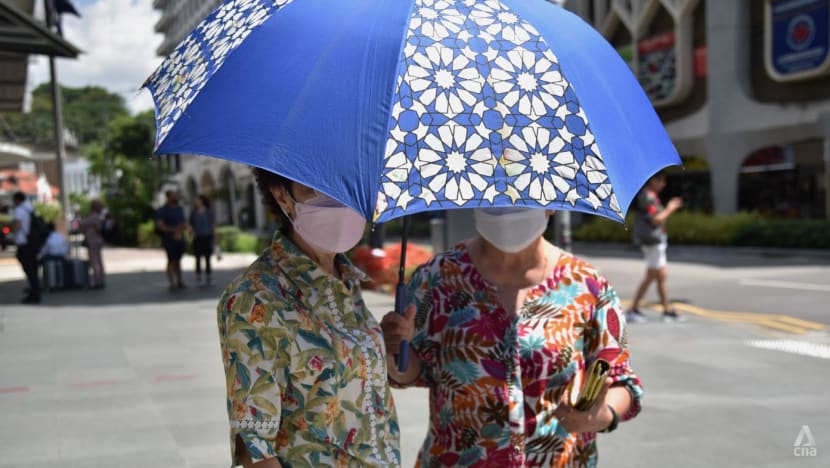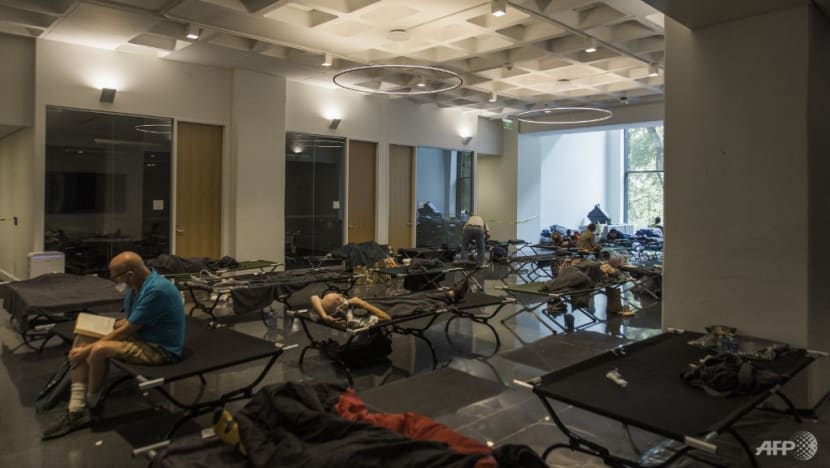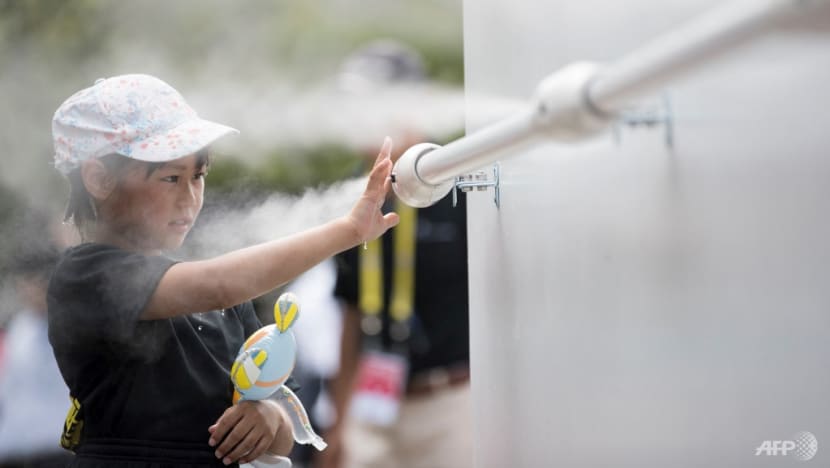Singapore
IN FOCUS: How will 40°C weather affect daily life in Singapore?
BookmarkShare
ADVERTISEMENT
Singapore
IN FOCUS: How will 40°C weather affect daily life in Singapore?
Singapore is projected to see daily highs of 40°C by 2045. Experts tell CNA how the rise in temperatures will change the way we live, work, study and play.
Illustration of a man on his commute, at work and jogging. (Illustration: CNA/Clara Ho)
 Davina Tham
Davina Tham
01 Jul 2023 06:00AM (Updated: 01 Jul 2023 11:52AM)
BookmarkShare
SINGAPORE: You wake up in the morning and check the temperature outside – it is 40 degrees Celsius. You pull on a short-sleeved shirt, shorts and sandals, and head to the office.
It is not casual Friday. This is what you’ve been wearing to work since your company changed the office dress code in response to rising temperatures.
ADVERTISEMENT
On your 15-minute walk to the MRT station, the path is fully shaded by sheltered walkways and rain trees. You stop to fill your bottle at one of the many water coolers along the way.
At your office, the air-conditioning is set at 25 degrees Celsius or above, as required by law. The office building, made of timber, is plugged into the district cooling system.
Home after work, you check your mobile app for heat guidelines – customised to your age, ethnicity and gender – to find out whether it’s fine to exercise outside in the blazing sun.
At the fitness corner downstairs, a misting system keeps you cool while you work out. Ducking into a neighbourhood cooling centre for a break, it is filled with elderly residents who have come for some air-conditioned comfort.
Before sleeping, a notification pings with the daily heat advisory, telling you if schools or offices will be open the next day. Another 40 degrees Celsius day is expected, so it is status quo.
ADVERTISEMENT
SCROLL TO CONTINUE WITH CONTENT
SCROLL TO CONTINUE WITH CONTENT
This might sound like a dystopian future, but Singapore is set to experience days with peak temperatures of 40 degrees Celsius as early as 2045, Minister for Sustainability and the Environment Grace Fu told parliament last year.
Already, the country matched a 40-year temperature record in May when the daily maximum temperature
hit 37 degrees Celsius in Ang Mo Kio.
Elsewhere in the region, heatwaves have killed dozens of people in India, where
temperatures soared above 45 degrees Celsius last month. Parts of China, the Philippines, Thailand and Vietnam have also experienced record-breaking temperatures near or past the 40-degree mark this year.
Warming in Singapore is driven by climate change globally and by the local urban heat island effect – when natural land cover is replaced by urban surfaces that absorb and store heat.
Two elderly woman sharing an umbrella under the hot weather in Singapore. (Photo: CNA/Syamil Sapari)
Professor Benjamin Horton, director of the Earth Observatory of Singapore at the Nanyang Technological University (NTU), expects the 37-degree ceiling to be broken in 2024, with
El Nino conditions projected to develop later this year.
ADVERTISEMENT
“Sometimes we dismiss a tenth of a degree because we’re used to the changes between night-time and day, where it can shift by 10 degrees Celsius,” he said.
But each increase by a tenth of a degree actually represents an “incredible” rise in temperature.
It is a myth that residents of equatorial Singapore are physiologically acclimatised to warming weather, experts told CNA.
“That is very untrue because the data is showing most Singaporeans spend their time indoors,” said Associate Professor Jason Lee, director of the Heat Resilience and Performance Centre at the Yong Loo Lin School of Medicine, National University of Singapore (NUS).
“So physiologically we are not, but behaviourally we are very acclimatised,” he said. “Behaviourally we are very good at escaping from the heat.”
ADVERTISEMENT
As the planet warms, escaping from the heat may not be sustainable. Instead, the way ahead will involve learning to live with the heat – from embracing nature-based solutions to adjusting the way people live, work and play in Singapore.
Related:

WORKING AND STUDYING IN A WARM WORLD
Forty degrees Celsius is not just a psychological threshold, but also approaches a physiological one.
A wet bulb temperature of 35 degrees Celsius is commonly thought of as the limit for human safety. A more recent study found that
31 degrees Celsius is the upper limit of heat stress for healthy young men and women – this corresponds to an air temperature of 38 degrees Celsius at 60 per cent humidity.
Singapore’s mean annual relative humidity is about 84 per cent. The body’s main mechanism for losing heat is through evaporation of sweat, which becomes harder when relative humidity is higher.
Heat stress occurs when the body is unable to dissipate excess heat. Without appropriate medical attention, this can progress to heat stroke, and may lead to multiple organ failure and death.
But before that point, heat stress can affect one’s ability to make decisions in the workplace and lead to more workplace accidents, Assoc Prof Lee said.
A 2017 study by researchers at Michigan State University and the University of South Florida found that exposure to heat resulted in workers perceiving the same activities as less risky, and increased their risk-taking behaviour.
“If the machine requires 10 steps and you are a very experienced worker, when you are very uncomfortable – in this case very hot – there is a tendency to say, let me get out of here as soon as possible. And therefore I might skip steps, and therefore accidents might happen,” said Assoc Prof Lee.
A hot environment can also affect one’s mood and compromise decision-making. The epidemiological data on this is very clear, he added.
“When it’s hot, people are moody, get more depressed, get angry. (In an) extreme case – suicide. So mental health is also indirectly affected due to the weather.”
Infants, the elderly and people with disabilities are more vulnerable to the heat. But heat stress can also arise when healthy adults exert themselves at work.
When it is hot, most people will decide to slow down and not work themselves too hard, said Assoc Prof Lee. But the risk calculation differs with socio-economic circumstances.
For example, said the associate professor, a delivery rider may think: “You’re telling me that I may die of heat injury – that’s a ‘may’. But I know if I don’t deliver 10 parcels a day, it will compromise my bread and butter. I’ve got kids at home, (I) will take the risk.”
This can lead people to work through thermal discomfort, making “over-motivation” and peer pressure significant risk factors for heat stroke.
Related:

The psychological impact of heat is also felt in schools, where concentration levels in the classroom will likely dip with uncomfortably high temperatures.
There is a very strong correlation between thermal comfort and student performance, said Professor Wong Nyuk Hien of the College of Design and Engineering, NUS.
In a 2022 study published in HSSE Online, a journal by the National Institute of Education, secondary school students were observed becoming more fidgety and talkative when the weather was warmer. They would zone out, rest their heads on the table and get frustrated, especially in the afternoon.
Teachers who participated in the study tried to vary the pace and style of teaching to keep students engaged. Some encouraged movement in the classroom or introduced short breaks between and during lessons, while others preferred that students stay in their seats to avoid generating more body heat.
The teachers also suggested that “dress-down” days – when students are allowed to wear physical education shirts with the usual uniform bottoms – should be allowed more frequently, and that more water coolers should be installed closer to the classrooms.
PUBLIC COOLING SHELTERS
Given the consequences of heat stress, does that simply mean more air-conditioning is needed?
About 80 per cent of households in Singapore own air-conditioners, according to the Department of Statistics. For many, it is their first option for respite on a hot day.
But conventional air-conditioners dump heat outside, causing outdoor temperatures to rise. This in turn encourages higher usage of air-conditioning and it creates a vicious cycle, said NUS’ Prof Wong.
About 60 per cent of the energy used to support a building goes towards cooling it, he added. This is not sustainable, the experts pointed out.
Air-conditioning should be “the last option” for cooling, and only for those who need it, said NUS’ Assoc Prof Lee.
“Those people who really need air-con don’t have air-con or don’t use air-con,” he said, pointing to manual labourers and the elderly who cannot afford it. In contrast, “people who don’t really need air-con are abusing” it.
To address this, Singapore could create public cooling shelters for vulnerable individuals, he said. Such shelters have been set up in Hanoi and around the US during heatwaves.
People spend the afternoon at a cooling centre at The Portland Building in Portland, Oregon on Aug 14, 2021, amid abnormally hot weather. (Photo: AFP/Michael Hanson)
The concept resembles that of a public bomb shelter. When the temperature hits a threshold, cooling shelters can be set up at Housing Board blocks and facilities like community centres. Other cooling methods can also be considered, such as giving out ice slurries.
This might mean the use of air-conditioning elsewhere can be restricted. Experts who spoke to CNA said there should be a mandatory temperature cap for air conditioners, suggesting 22 or 25 degrees Celsius as the floor below which temperatures are not allowed to go.
“Rather than guidelines, make it legal. Put it in the justice system. You are not allowed unless you’ve got a medical exemption,” said NTU’s Prof Horton.
To encourage behavioural changes, there could be stronger policy measures penalising organisations that do not adapt to increased heat exposure, said the Singapore Management University’s (SMU) Associate Professor Winston Chow, a principal investigator of the Cooling Singapore research project.
Ensuring that safety and health regulations protect workers from heat exposure will also become even more important. For outdoor workers, these may be policies looking at their right to water and shade, as well as the option to cease work if it is too hot, he added.
Heat guidelines will need to incorporate data from more diverse groups of people so they can be more personalised, said NUS’ Assoc Prof Lee.
For office and uniformed workers, moving away from long-sleeved shirts, long trousers and covered shoes is also an obvious change as the world warms. This involves a shift in perspective on “looking smart”, said Assoc Prof Lee.
“The uniform must be functional first, then the smartness,” he said, pointing to the Bermuda shorts and polo shirts worn by some police officers as a positive example.
Related:

THE FUTURE OF COOLING
The sight of rows of air-conditioning condenser units blowing hot air back into streets could disappear in the future, if district cooling expands from Marina Bay and Tengah to become the default across the island.
District cooling uses cold water chilled in a centralised plant to cool buildings through a network of pipes. This is meant to improve energy efficiency through economies of scale and reduce carbon emissions from refrigerants.
As outdoor temperatures rise, should open-air spaces like hawker centres become enclosed, so that air-conditioning can be installed? Prof Wong doesn’t think that is necessary.
Hawker centres are more like a “transitional space” than a place where people dwell and focus on work, he said.
Corridors and atriums of buildings fall into the same category. A warmer Singapore could actually see less air-conditioning if it is removed from such transitional spaces.
Rows of air conditioning condenser units lining the back of a building in Singapore. (Photo: CNA/Calvin Oh)
A hybrid ventilation system combining fans and air-conditioning – at a higher temperature of about 27 degrees Celsius – could also become the norm. Such a system is already in use in NUS’ Net-Zero Energy Building @ SDE.
Buildings could become cooler if construction moves away from using concrete, which stores heat well and emits significant volumes of greenhouse gases during production.
As an alternative, Prof Wong pointed to the use of timber – such as in a newly opened six-storey, zero-energy development in NTU, touted as the largest wooden building in Asia.
Compared to concrete, timber has low thermal mass, meaning that its ability to absorb and store heat is low. This is preferred in hot and humid climates. In contrast, high thermal mass materials like concrete, if left unshaded, may absorb solar energy throughout the day and release it into the building at night.
In addition to using timber, NTU’s building – called Gaia – uses sun shades on its facade and open areas, terraces and air wells to increase ventilation.
To make buildings more comfortable in the heat, designers and developers should go back to traditional design features like orientation relative to the sun, shade and natural ventilation, while relying less on glazed windows, said Prof Wong.
Innovations like “cool paint”, a type of paint containing additives that reflect heat from the sun, could also make a difference. A cool paint pilot with Housing Board flats in Tampines aims to reduce ambient temperature by 2 degrees Celsius.
Related:


SHOULD WORK START LATER IN THE DAY?
With all the effort and energy needed to keep cool in the daytime, would Singapore reach the point of scheduling work and other essential activities to start later in the day and end well after dark?
That’s not desirable as working overnight has its own drawbacks, according to NUS’ Assoc Prof Lee. The night shift interrupts circadian rhythms and social lives, and workers may start work without being well rested, putting their safety at risk. The need for lighting will also put extra pressure on the power grid.
But even if normal work hours are maintained, leisure patterns, including recreational sports, are likely to change. There is a tendency during warm weather for people to stay indoors as much as possible, only venturing outside in the evening.
This is reinforced by official guidelines. For instance, the Ministry of Education encourages schools to minimise outdoor physical activities between 10.30am and 3.30pm on warmer days.
As temperatures rise, this blackout period could lengthen. But trying to avoid being outside on hot days can lead to a decrease in outdoor physical activity and in turn, affect mental health, Assoc Prof Lee pointed out.
Instead of hardening the boundaries around the hours that people should not exercise outdoors, another approach would be to embrace the heat and manage it.
“We feel heat as a distress. Heat is actually a stressor ... All stressors, if you know how to use (them) creatively, can be eustress”, or a beneficial form of stress, said Assoc Prof Lee.
Exercise could be planned for the hottest times of the day in order to put extra strain on the body and maximise training outcomes, said Assoc Prof Lee. To compensate, the workout could be less intense or shorter.
“Training is all about creating strain so that your body can respond … Now with heat, in 30 minutes you get your heart rate to the same level as compared to your old condition (where) you had to do it in 45 minutes,” he said.
“You want to do 45 minutes at 8am, or 30 minutes at 12 noon? You can actually save your time by reaching the same endpoint faster. That, to me, is training efficiency.”
In hot yoga, practitioners intentionally use heat to intensify physical activity. Instead of practising in artificially heated rooms, for instance, such classes can be held outdoors in unshaded areas when the sun is high on a 40-degree day.
To manage the heat risk, public misting systems that spray ultrafine water droplets onto people can be set up at more parks, exercise corners and even playgrounds, said Prof Wong.
At the Tokyo 2020 Olympics, when heat and humidity soared during Japan’s summer, the Games organisers and national teams used misting fans to cool athletes and even horses.
A girl cools off at a mist station installed at Shiokaze Park during the beach volleyball test event for the Tokyo 2020 Olympic Games in Tokyo on Jul 25, 2019. (Photo: AFP/Behrouz Mehri)
A heat advisory system will be important to prime people for hotter weather, and also to make sure that healthcare and emergency services are prepared for more heat injuries, added SMU’s Assoc Prof Chow.
Then there are the unavoidable outdoor activities, like the last mile walk from public transport nodes to one’s destination.
In a warmer Singapore, Walk2Ride – the Land Transport Authority’s programme to build covered walkways for residents within 400m of all MRT and LRT stations and bus interchanges – could be expanded to more locations.
Nature-based solutions, in the form of trees with broad canopies, could also become more widely used for shade, said Assoc Prof Chow.











